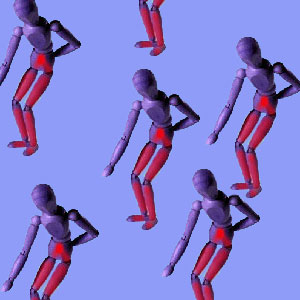
Sciatica weakness is one of the four symptomatic horsemen of the back pain apocalypse. Weakness might be actual, or only perceived, but is a real concern for any patient suffering from severe sciatica symptoms. Although weakness might be experienced alone, it is typically associated with pain, tingling and numbness, especially in chronic sciatica conditions.
This article resource section will provide an overview of weakness experienced in association with sciatica. We will also provide a number of detailed essays each covering sciatica weakness in a particular area of the lower anatomy for additional research.
Sciatica Weakness Case Profiles
Weakness is generally the last symptom to show up during any sciatica pain condition. Pain and tingling are usually the first, sometimes followed by alternating bouts of numbness. As the condition persists, weakness will often set in and make the patient feel as if they can not function to full physical capacity. Sometimes, the poor individual feels as if they can not even stand up on their own. This is especially true if the weakness is felt in the very lowest area of the back or in the buttocks and hip regions.
Weakness is very scary, since it truly makes a person feel as if they have lost control of their own body. Weakness is almost always theorized to exist due to innervation problems involving the sciatic nerve. This means that since the legs and feet depend on the sciatic nerve to provide them with all the signals they receive from the brain, physical functionality can be diminished when these signals are interrupted by a structural or nonstructural process.
Weakness Dialogs
Sciatica weak legs feel incapable of normal function at all times, while sciatica tired legs usually only suffer diminished ability after substantial exertion. Regardless, the symptom of leg weakness is virtually universal among chronic sciatica patients.
Sciatica Weakness Conditions
Weakness is associated with most severe back and neck pain syndromes, but sometimes for the wrong reasons. Typically, sciatica is blamed on a pinched nerve in the lower spine, caused by some structural condition, such as a herniated disc or arthritis osteophyte.
Although herniated discs and osteoarthritis can create pain in some instances, they are mostly coincidental and innocent spinal scapegoats on which sciatica pain is mistakenly blamed. This is because most of these spinal irregularities do not definitively influence the surrounding nerve anatomy and therefore are basically incapable of causing the very pain blamed on them. Of course, when nerve interaction is definitive and the spinal condition is verified as being pathological, then the diagnosis is correct and should lead to successful therapy.
Weakness in the postural muscles, legs and feet can also be caused by sciatic nerve compression enacted by the piriformis muscle. It can be sourced if a tumor or cyst grows on or near a nerve and affects the signal capacities of that nerve.
Weakness can be the result of localized injury or nerve disorders. It can also be the result of a disease process, such as fibromyalgia or chronic fatigue syndrome.
Finally, weakness can be enacted by oxygen deprivation. This epidemic process is also commonly called ischemia and affects untold numbers of patients suffering from various chronic pain syndromes throughout the body.
Sciatica Weakness Experiences
I am sure that you have some diagnosis which has driven you to treatment for your weakness, pain, tingling and numbness. You are probably reading this because all your sciatica treatments have failed. There is probably nothing wrong with the treatments you have attempted to cure your pain, if the diagnosis is indeed correct. But, there is the rub…
Misdiagnosed sciatica is the main reason for treatment failure. Patients question whether their doctors are using the correct methods to treat their sciatica, but never question the diagnosis of sciatica itself. To me, it seems like questioning the diagnosed source of the pain is far more logical than questioning the effectiveness of perhaps a dozen different treatment options. What do you think? Makes sense.
Well, I have a bit more concrete proof than mere speculation. I suffered for decades from misdiagnosed back pain which was blamed on degenerative disc disease and 2 herniated discs in my lumbar spine. I was told my sciatica and lower back pain was definitely due to nerve root compression at L4/L5 and L5/S1. Well, I ran the gauntlet of treatment for 18 years, but my pain grew progressively worse. It got to the point where I was at my wits end, but my pain was just beginning.
Weakness in the Lower Back, Legs and Feet
Weakness is a logical result of a lack of proper innervation of muscular structures. However, the areas affected must correlate to the theorized sources, since every spinal nerve root provides nerve energy for highly specific regions of the anatomy.
In many diagnosed pinched nerves, the symptoms do not correlate. In fact, in the majority of these diagnosed nerve compression conditions, the symptoms are much too diverse to be correctly sourced. Central spinal stenosis is another matter altogether, with large areas of variable weakness being possible throughout the body.
I highly recommend you research more about your specific diagnosis and then decide whether the symptoms you are actually suffering from make sense, considering the clinical expectations of the theorized source. This is a great place to start when trying to cure chronic weakness in the back, buttocks, legs or feet.





